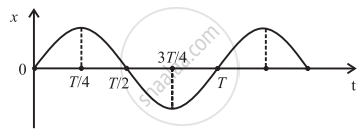Advertisements
Advertisements
प्रश्न
Answer in brief.
Using differential equations of linear S.H.M, obtain the expression for (a) velocity in S.H.M., (b) acceleration in S.H.M.
State the differential equation of linear S.H.M. Hence, obtain the expression for:
- acceleration
- velocity
उत्तर
Differential equation of SHM
∴ `(d^2x)/(dt^2) + omega^2.x = 0` ............(i)
(a) Obtaining expression for acceleration:
`(d^2x)/(dt^2) = -omega^2.x` ........[From (i)]
But `a = (d^2x)/(dt^2)` is the acceleration of the particle performing SHM.
∴ a = `-omega^2.x`
This is the expression for acceleration.
(b) Obtaining expression for velocity:
`(d^2x)/(dt^2) = -omega^2.x` ..............[From (i)]
∴ `d/dt((dx)/(dt)) = -omega^2.x`
∴ `(d"v")/(dt) = -omega^2.x`
∴ `(d"v")/(dx)(dx)/(dt) = -omega^2.x`
∴ v`(d"v")/(dx) = -omega^2.x`
∴ v.dv = -ω2.x.dx
Integrating both sides, we get
`int"v".d"v" = -omega^2intx.dx`
∴ `"v"^2/2 = -omega^2.x^2/2 + C` ...........(iii)
Where C is the constant of integration.
Let A be the maximum displacement (amplitude) of the particle in SHM.
When the particle is at an extreme position, velocity (v) is zero,
Thus, at x = ±A, v = 0,
Substituting v = 0 and x = ±A in equation (ii), we get
∴ `0 = -omega^2. A^2/2 + C`
∴ C = `omega^2.A^2/2`
Using the value of C in equation (ii), we get
∴ `"v"^2/2 = -omega^2.x^2/2 + omega^2.A^2/2`
∴ `"v"^2 = omega^2(A^2 - x^2)`
∴ v = `±omegasqrt(A^2 - x^2)`
This is the expression for velocity.
संबंधित प्रश्न
Choose the correct option:
The graph shows variation of displacement of a particle performing S.H.M. with time t. Which of the following statements is correct from the graph?

Find the change in length of a second’s pendulum, if the acceleration due to gravity at the place changes from 9.75 m/s2 to 9.8 m/s2.
Two identical wires of substances 'P' and 'Q ' are subjected to equal stretching force along the length. If the elongation of 'Q' is more than that of 'P', then ______.
The displacement of a particle from its mean position (in metre) is given by, y = 0.2 sin(10 πt + 1.5π) cos(10 πt + 1.5π).
The motion of particle is ____________.
In U.C.M., when time interval δt → 0, the angle between change in velocity (δv) and linear velocity (v) will be ______.
A wheel of M.I. 50 kg m2 starts rotating on applying a constant torque of 200 Nm. Its angular velocity after 2.5 second from the start is ______.
If 'α' and 'β' are the maximum velocity and maximum acceleration respectively, of a particle performing linear simple harmonic motion, then the path length of the particle is _______.
A particle executing S.H.M. has amplitude 0.01 m and frequency 60 Hz. The maximum acceleration of the particle is ____________.
The displacement of a particle is 'y' = 2 sin `[(pit)/2 + phi]`, where 'y' is cm and 't' in second. What is the maximum acceleration of the particle executing simple harmonic motion?
(Φ = phase difference)
The length of the second's pendulum is decreased by 0.3 cm when it is shifted from place A to place B. If the acceleration due to gravity at place A is 981 cm/s2, the acceleration due to gravity at place B is ______ (Take π2 = 10)
A simple pendulum of length 'L' is suspended from a roof of a trolley. A trolley moves in horizontal direction with an acceleration 'a'. What would be the period of oscillation of a simple pendulum?
(g is acceleration due to gravity)
The bob of a simple pendulum is released at time t = 0 from a position of small angular displacement. Its linear displacement is ______.
(l = length of simple pendulum and g = acceleration due to gravity, A = amplitude of S.H.M.)
The displacement of the particle performing S.H.M. is given by x = 4 sin πt, where x is in cm and t is in second. The time taken by the particle in second to move from the equilibrium position to the position of half the maximum displacement, is ______.
`[sin30^circ=cos60^circ=0.5, cos30^circ=sin60^circ=sqrt3/2]`
A body perform linear simple harmonic motion of amplitude 'A'. At what displacement from the mean position, the potential energy of the body is one fourth of its total energy?
A particle of mass 5 kg moves in a circle of radius 20 cm. Its linear speed at a time t is given by v = 4t, t is in the second and v is in ms-1. Find the net force acting on the particle at t = 0.5 s.
The displacement of a particle of mass 3 g executing simple harmonic motion is given by Y = 3 sin (0.2 t) in SI units. The kinetic energy of the particle at a point which is at a distance equal to `1/3` of its amplitude from its mean position is ______.
A body of mass 0.5 kg travels in a straight line with velocity v = ax3/2 where a = 5 m–1/2s–1. The change in kinetic energy during its displacement from x = 0 to x = 2 m is ______.
In the given figure, a = 15 m/s2 represents the total acceleration of a particle moving in the clockwise direction on a circle of radius R = 2.5 m at a given instant of time. The speed of the particle is ______.

Calculate the velocity of a particle performing S.H.M. after 1 second, if its displacement is given by x = `5sin((pit)/3)`m.
For a particle performing circular motion, when is its angular acceleration directed opposite to its angular velocity?
Which one of the following is not a characteristics of SHM?
